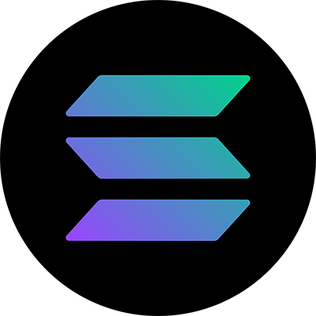
Solana Emerges as Tokenization Powerhouse, Riding 140% Surge in Real-World Assets
Solana Emerges as Tokenization Powerhouse, Riding 140% Surge in Real-World Assets
The Lightning Chain's Quiet Revolution in Traditional Finance
In the shadow of cryptocurrency's volatile headlines, a financial transformation is taking root on the Solana blockchain. The network has witnessed an extraordinary 140.6% surge in tokenized real-world assets since January, with total value now exceeding $418 million—dramatically outpacing the broader tokenization market's 62.4% growth during the same period.

This explosive expansion represents more than just numbers on a ledger. It signals a fundamental shift in Solana's identity from a playground for speculative memecoins to a serious contender in institutional finance, capturing nearly 4% of the global tokenized asset market.
"What we're seeing isn't just adoption—it's validation," notes a senior blockchain analyst tracking institutional movements. "Traditional finance is no longer asking if they should tokenize assets, but which blockchain offers the optimal infrastructure."
Solana's Real-World Asset (RWA) ecosystem has demonstrated explosive growth, surging over 140% year-to-date to a total value exceeding $418.1 million. While the leading asset, USDY, maintains the largest market share, the most significant momentum is emerging from newer and smaller protocols. Notably, the "Other" category of unlisted assets has seen a staggering 605% YTD increase, indicating a rapidly broadening and diversifying landscape. Among established players, OUSG is a standout performer, growing its value by over 275% in the same period. This data suggests that while the ecosystem has a clear leader, the highest growth velocity and potential for emerging opportunities may lie within the long tail of new RWA projects launching on the network.
Beyond the Hype: Hard Numbers Paint a Compelling Picture
The metrics tell a story of accelerating momentum. Solana now ranks fourth in the RWA sector behind Ethereum (which commands 58.4% market share), ZKsync Era, and Aptos. This positioning is particularly notable given Solana's relative youth compared to market leader Ethereum.
More striking is the composition of this growth. Major protocols like Ondo (U.S. Dollar Yield Fund) and ONe (institutional fund) account for approximately $277 million—over 65% of tokenized assets on Solana. This concentration reflects both strength and vulnerability, as it demonstrates institutional confidence while creating dependency risk.
User adoption metrics are perhaps most revealing. Wallets holding tokenized stocks on Solana have increased by an astonishing 5,349% in just 30 days, reaching 42,940 active addresses. This surge indicates the ecosystem is rapidly expanding beyond institutional early adopters to include sophisticated retail participants.
Solana RWA Market Breakdown (July 7, 2025)
| Asset / Protocol | RWA Value (USD) | YTD Change | Share of Total |
|---|---|---|---|
| USDY | $175.3M | +62.4% | ~41.9% |
| OUSG | $79.6M | +275.1% | ~19.0% |
| ACRED | $26.9M | N/A* | ~6.4% |
| BUIDL | $25.9M | N/A* | ~6.2% |
| BENJI | $25.2M | N/A* | ~6.0% |
| TBILL | $13.6M | N/A* | ~3.3% |
| Other | $71.5M | +605% | ~17.1% |
| Total | $418.1M | +140.6% | 100% |
The Speed-Cost Equation That's Changing Market Structure
Why Solana, and why now? The blockchain's technical architecture appears to have crossed a critical threshold for institutional requirements.
Recent live-fire tests of Firedancer—Solana's new client implementation—achieved benchmarks of 1 million transactions per second with 400 millisecond finality. These specifications move Solana from merely "fast" to what industry insiders describe as "market-structure grade," capable of supporting high-frequency trading operations or repurchase agreement desks.
"The throughput-cost frontier is where traditional finance becomes practical on-chain," explains a financial infrastructure specialist familiar with institutional requirements. "Sub-second finality combined with transaction fees measured in fractions of a cent creates an environment where the economics finally make sense."
Liquidity Foundations and Regulatory Tailwinds
The raw material for this growth was laid in March when Circle minted $250 million USDC in a single day on Solana, helping push on-chain stablecoin liquidity above $10 billion. This depth of fiat-backed tokens creates the necessary settlement layer for more complex financial instruments.
Regulatory developments have also played a catalytic role. The recently signed GENIUS Act establishes disclosure requirements for stablecoin reserves, providing a clearer framework for fiat-backed tokens that facilitate RWA trading. While not directly addressing tokenized Treasuries, this legislation represents a significant step toward normalizing blockchain-based financial infrastructure.
The Revenue Reality Check
Despite the impressive growth metrics, Solana's valuation requires scrutiny. The network generated $3.9 million in protocol revenue from RWAs over the past 30 days, compared to Ethereum's $15.9 million during the same period. Annualizing these figures suggests a fully diluted value-to-revenue ratio of approximately 2,340× for Solana versus 1,820× for Ethereum.
"Both blockchains trade at multiples that would make traditional finance analysts blanch," observes a crypto-focused portfolio manager. "Solana's premium can only be justified if Firedancer eliminates the outage risk discount and RWA fees grow substantially within the next year."
The Risk Equation: Technical Stability Remains the X-Factor
For institutional allocators, Solana's historical vulnerability to network outages remains the primary concern. The Firedancer implementation represents a critical technical overhaul, but as effectively a new client, concurrency bugs are considered inevitable by many developers.
Regulatory uncertainty also looms large. Stock tokens with no claim on underlying assets remain in a gray area, with recent Financial Times reporting highlighting the distinction between "RWA" and actual regulatory compliance.
"The concentration risk cannot be overstated," warns a digital asset risk officer. "With two protocols representing over 65% of Solana's RWA ecosystem, a single administrative issue could dramatically impact total value locked."
Investment Implications: Seeking Alpha Beyond Token Accumulation
For professional traders seeking to capitalize on these developments, several strategic approaches emerge from current market conditions:
A relative-value play between Solana and Ethereum, structured as a delta-neutral position long SOL and short ETH, could benefit from compression in the price-to-revenue gap if Solana's RWA revenue continues to outpace Ethereum's.
Basis trading opportunities exist where OUSG tokens on Solana currently trade at a 0.7% premium to equivalent traditional T-bill ETFs. As cross-chain bridges improve, this spread is expected to narrow.
Volatility arbitrage presents another avenue, as options on tokenized equities currently price in risk premiums more than double those of traditional exchanges—potentially offering opportunities for covered call strategies.
Looking Forward: Infrastructure Over Assets
The most compelling risk-adjusted opportunities may lie not in the SOL token itself but in the infrastructure layer supporting Solana's RWA ecosystem. Custody solutions, oracle networks, and transfer-agent middleware represent targeted exposures to the tokenization trend without direct token volatility.
For allocators who maintain SOL positions, establishing clear technical and regulatory catalysts as exit triggers will be essential. The remarkable growth in Solana's RWA ecosystem demonstrates that blockchain technology can win legitimate, fee-generating financial business—but only in a permissive regulatory environment and with flawless technical execution.
As the tokenization race accelerates, Solana has proven it belongs in the conversation. Whether it justifies its current valuation premium will depend on its ability to convert technical advantages into sustained institutional adoption while navigating an evolving regulatory landscape.
Disclaimer: This analysis is intended for informational purposes only and does not constitute investment advice. Past performance does not guarantee future results. Readers should consult with qualified financial advisors before making investment decisions.